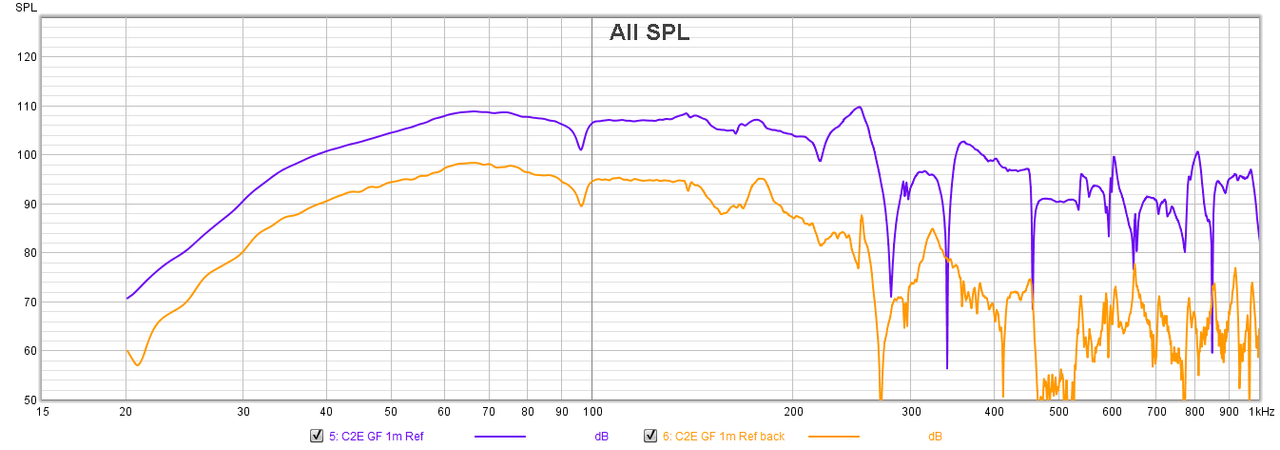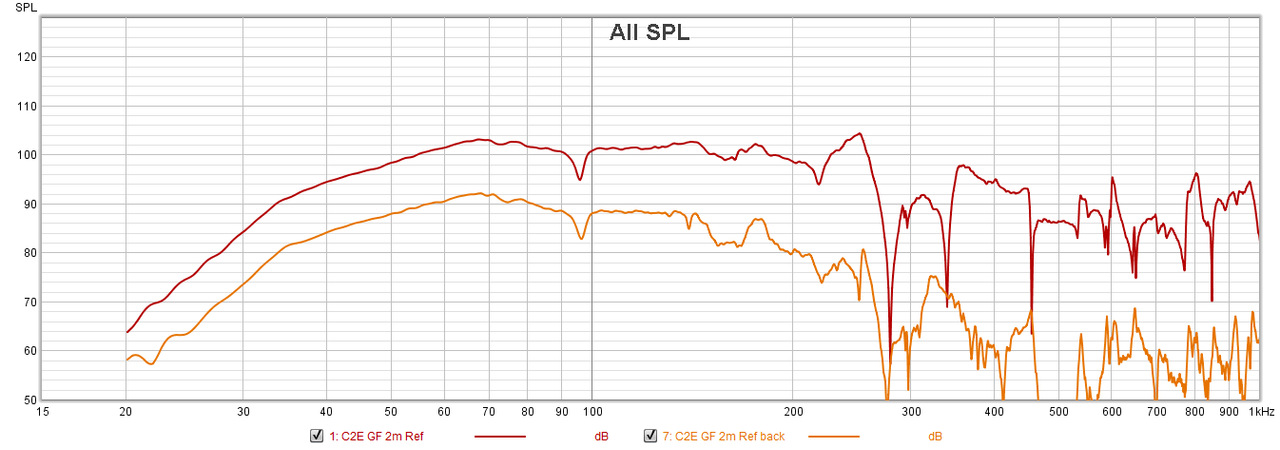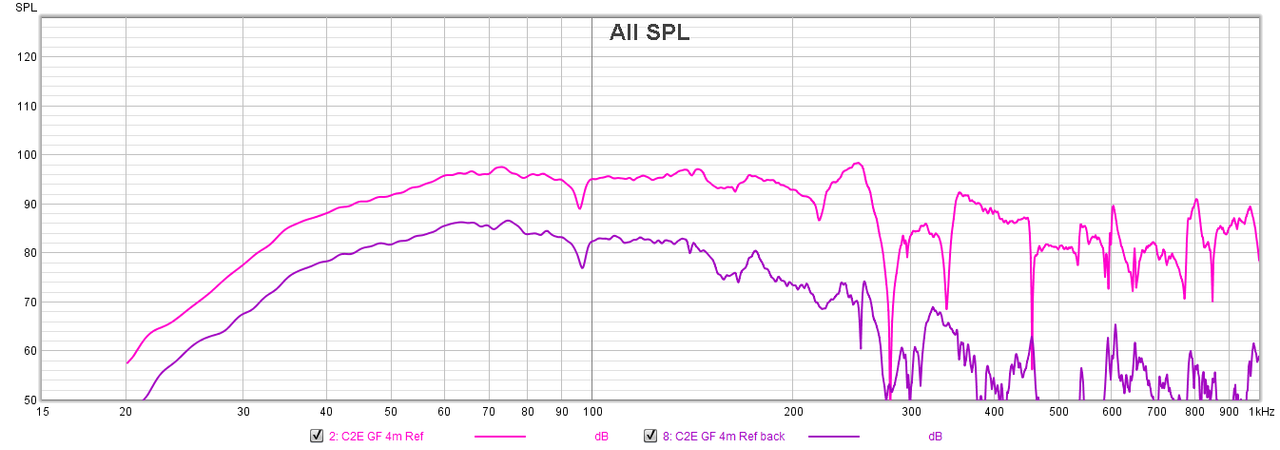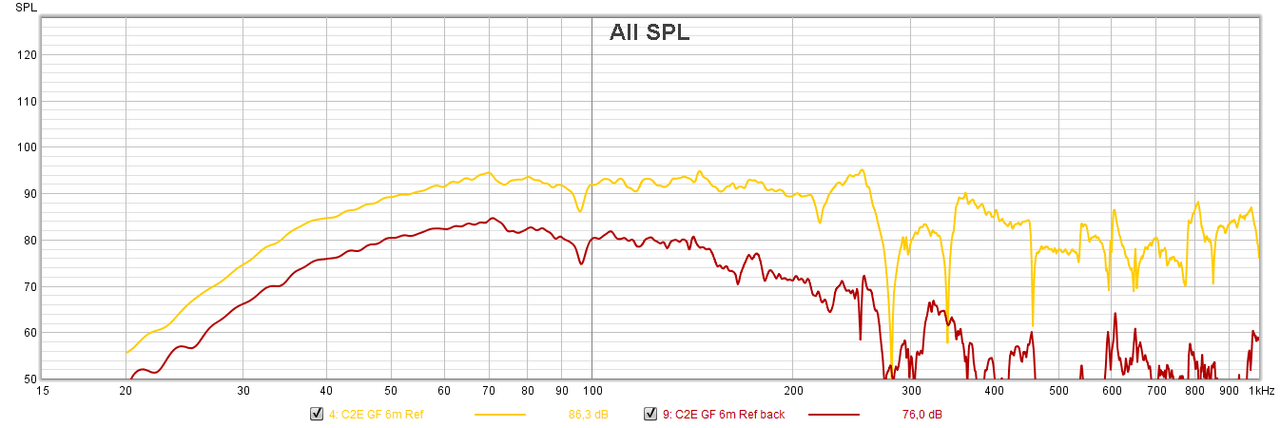
 |
Skram vs. C2E - Subwoofers info research |
Post Reply 
|
Page <12345 7> |
| Author | ||
T Willy 
Registered User 
Joined: 07 February 2022 Location: Wisconsin Status: Offline Points: 43 |
 Post Options Post Options
 Thanks(0) Thanks(0)
 Quote Quote  Reply Reply
 Posted: 08 February 2022 at 1:22pm Posted: 08 February 2022 at 1:22pm |
|
Agreed. I have noticed a large amount of rear rejection with the C-2E as well. Funny thing is that it seems to be more prominent above a certain frequency. An educated guess i would say above 50 hz. Id like to test this some time with 360 deg of measurements at 8 points around the subwoofer. Chosen distance and calibrated mic. Would be interesting to find out what it is actually doing per response to level.
|
||
 |
||
toastyghost 
The 10,000 Points Club 

Joined: 09 January 2007 Location: Manchester Status: Offline Points: 10919 |
 Post Options Post Options
 Thanks(0) Thanks(0)
 Quote Quote  Reply Reply
 Posted: 08 February 2022 at 6:27pm Posted: 08 February 2022 at 6:27pm |
|
|
Measuring rear rejection has to be done properly, and that’s a problem if you’re in the near field where cabinet shadowing will be occurring.
The first thing is to ensure that the rear position is equi-temporal with the front one. And that also means finding the acoustic centre, if you want to check near field rejection. Then you have to go a decent distance from that, at least a few metres, in both directions. You’ll find that any box of a dual 18” size has 3-5 dB near field rear rejection like this thanks to the cabinet’s shadowing. That's also present on a TH118XL and is what I see in the last imgur link too, but it isn't particularly exceptional. I think confusion maybe stems from people not realising that most of the larger manufacturers refer to far field data, as this is where the vast majority of listeners to PA systems are going to be. Anyone who has setup a wall of horn subs will notice this too, but while impressive up close it isn’t often very useful in real life once you get to distance. The best thing is still to measure in the far field, where it matters. 10 metres (which is what the polar maps are generated at in my model) is a good indicator for real, useful rejection. The model uses the boundary element method, which solves the wave equation in 3D as a partial differential equation called the Helmholtz-Kirchhoff integral - so all cabinet geometry effects are included, unlike an isophase lumped element model like Hornresp. You’ll see on the animated heat map of output that close to the cabinet there is a drop of 3-5 dB in the colour allocation, but this disappears in the far field. This effect is also created primarily by the cabinet’s size and shape, including the size of the radiating area on the front, regardless of internal layout. I spent 7 months researching this last year, with real-world measurements to qualify plenty of models. There’s always plenty of room for more investigation, but I the only thing I can see about the Paraflex alignment which could cause rear rejection is the fact that a lot of the low and upper corner response has phase offsets created by the stacked series resonant pipes. You can see a similar but less exaggerated effect in the response ripple of a straight transmission line, and those are modelled very well by a BEM model of sufficient mesh resolution. Cardioid system designs such as gradient or end-fire have to be made with consideration as to whether you want a ‘clean stage’ or to avoid upsetting the neighbours many miles away. It is a case of ‘pick one’ usually, and only physical acoustic circuits like the Fulcrum patent or the Danley BC achieve both. As an aside, I appreciate you guys popping out of the FB group to share the data. I genuinely think a lot of these concerns stem from the somewhat insular nature of the community and the use of Facebook for it. Sometimes the fast-moving chat and flood of cabinet drawings on the HOQS can come across like some magic bullet has been found, even if that isn't the intention. Plus, the data on there isn't yours and isn't easily shareable outside. What would you do if the group gets Zucc'd?! We've all been excited and inexperienced at gathering worthwhile data, but learning happens a lot faster if things a presented more as questions and discussion across a broader range of communities. |
||
 |
||
Ricci 
Registered User 
Joined: 13 March 2017 Location: Louisville, KY Status: Offline Points: 69 |
 Post Options Post Options
 Thanks(0) Thanks(0)
 Quote Quote  Reply Reply
 Posted: 08 February 2022 at 9:23pm Posted: 08 February 2022 at 9:23pm |
|
Hey Jay...Fancy meeting you here. Thanks for posting since you have some experience with cabs of both types. It's too bad we aren't closer. I'd talk you into letting me borrow a few cabs for a full workup over the summer. I wonder if there are any C2E cabs near me in the US...Perhaps something worth looking into as I'm planning to get back at it this year. I don't really see any more attenuation to the rear than expected in the measurement. There will be some up close to the cabs simply due to the size of the cabinet and pathlength differences from the radiation point around the physical boundaries of the cab. Measurements from a larger distance such as 10m mitigate these and other issues. I don't see anything about the generic cab design that would explain greatly increased attenuation to the rear vs other similar size /shape cabs. Then again you and others are reporting something going on. It makes me wonder. Measurements should be able to show it if it's there and identify a cause if so.
|
||
 |
||
Jay michali 
Registered User 
Joined: 10 January 2019 Status: Offline Points: 26 |
 Post Options Post Options
 Thanks(0) Thanks(0)
 Quote Quote  Reply Reply
 Posted: 08 February 2022 at 11:07pm Posted: 08 February 2022 at 11:07pm |
|
Hey Josh, good to hear from you as well. Remind me where you are located again? Ill ask around, perhaps there is someone in your area who would donate a cabinet to get the proper data-bass treatment. Would be nice to see the Skram get measured up properly as well, I keep hearing of more and more getting build up here in Canada. From my knowledge there are at least 16 of them in western Canada at the moment with another 6 in the planning process.
|
||
 |
||
Jay michali 
Registered User 
Joined: 10 January 2019 Status: Offline Points: 26 |
 Post Options Post Options
 Thanks(0) Thanks(0)
 Quote Quote  Reply Reply
 Posted: 08 February 2022 at 11:12pm Posted: 08 February 2022 at 11:12pm |
|
Thanks again for the great info Toasty. I do have access to a large paved parking lot at our studio, 10 meter measurements would be easy to pull off. I will try to make this happen, snow usually clears up around here in later march or early April. Super appreciate the detailed response, super helpful information |
||
 |
||
JBK 
Registered User 
Joined: 03 March 2016 Location: Besançon Status: Offline Points: 262 |
 Post Options Post Options
 Thanks(0) Thanks(0)
 Quote Quote  Reply Reply
 Posted: 09 February 2022 at 10:36am Posted: 09 February 2022 at 10:36am |
|
|
I have nothing to contribute but wanted to thanks everyone for your input, that's a brilliant thread.
|
||
 |
||
Ricci 
Registered User 
Joined: 13 March 2017 Location: Louisville, KY Status: Offline Points: 69 |
 Post Options Post Options
 Thanks(0) Thanks(0)
 Quote Quote  Reply Reply
 Posted: 10 February 2022 at 8:22pm Posted: 10 February 2022 at 8:22pm |
|
Louisville KY, USA is where I'm based. Really far away from Canada, or Europe! I'm working on that 2nd part. Need to do a Ckram too.
|
||
 |
||
MMJ of HOQS 
Registered User 
Joined: 10 February 2022 Location: United States Status: Offline Points: 61 |
 Post Options Post Options
 Thanks(0) Thanks(0)
 Quote Quote  Reply Reply
 Posted: 11 February 2022 at 9:21am Posted: 11 February 2022 at 9:21am |
|
|
Hello everyone!
 Considering how the topic of some rear-rejection or a directional effect as observed with the HOQS Paraflex subwoofers has become a focus of this discussion it is helpful for us to have more real world data for us to work with, so with that in mind here (below) are some contributions from our friend Patrick Sander in Munster Germany ... These are multiple outdoor measurements taken at distances ranging from 1m to 10m.... The subject is a single Paraflex Golden Formula C-2E 1x18 subwoofer in a field .....Fundamental tuning of this cabinet is 35hz... This cabinet's outer dimensions are 24" x 48" x 36" .. At each distance he first measured with this cabinet facing the microphone on-axis, and then without changing the position of the mic (or measurement settings) a second measurement was taken after turning the cabinet around (facing away from the microphone) while keeping our cabinet located in the very same place ... First at 1 meter:  Then at 2 meters:  Here we are at 4 meters:  At 6 meters, still looking great here:  Then finally at 10 meters (almost 33 feet) :  As you can see this amount of rear-rejection which we have in these charts coincide fairly well with what we see in the chart at the link which Jay Michali shared in this discussion earlier ....... Jay's Paraflex subwoofer is of a different design being a Type "A" layout based Paraflex as opposed to the GF C-2E Paraflex which Patrick has, so you can see that the dip & bump features are in different locations but the amount of rear rejection is very similar . . In case anyone missed it earlier here is the chart which Jay had kindly provided:  So the effect has been measured out to 10 meters, and is still pronounced at 10 meters .. . We cannot yet say for sure if it diminishes beyond that point but nevertheless 10 meters is almost 33 feet and many stages aren't even 33 feet deep, so this is in fact a useful feature of HOQS Paraflex subwoofers, and it is one which has already been used to a practical advantage during shows & events, even by some who have responded in this discussion .. . A few examples of reports include a happily acceptable amount of bass energy on stage despite the array of Paraflex subwoofers being located directly in front of that stage, and another report included avoidance of noise complaints from a certain direction (as opposed to other more conventional cabinets which had previously been used in that particular challenging event space generating more complaints from neighbors without producing any more SPL on the dance floor ..)... A combination of consistent measured data & consistent reports from experienced people whom we trust is extremely valuable to us... After all these fellows are in the trenches with our boxes..... They come from various backgrounds & other forums (some are from Speakerplans apparently and are still members) ..... They have various levels of experience but some of them are seasoned industry veterans who have worked with many more PA cabinets in the field than I ever did, so contrary to whatever perceptions there may or may not be this community is quite the opposite of "insular" (if that word was used in the derogatory sense, but of course not, since there is no place for that sort of thing in a technical forum) .... In other words what they have to say holds a lot of weight, and is much preferred over conjecture from afar .. We do encounter skepticism all of the time and I can totally understand why...... I would probably be skeptical too if coming from an outside perspective ...... Of course it doesn't help that Akabak is not predicting the sort of passive-cardioid or rear-rejection effect that we are measuring, and it was one of our own developers by the name of Tom Armitage-Giles (also of The UK) who was the first to point this out to us a while back when the predicted pattern in his Akabak simulation of a Paraflex subwoofer did not even remotely resemble the reports ....... Not sure if anyone ever figured out why that is (note: it was inconclusive and probably never even hit the public feed for that reason), however, Tom is fully brilliant so I don't doubt his Akabak skills..... Toasty, if you don't know Tom already you two should connect, he is a good guy, highly recommended  Yes, the Facebook group is fast paced which can often be fun but posts do get buried quickly and we also realize that it is not always easy to navigate and find what you want, unless you know exactly how to go about it and even then is a little tricky at times ........ Yes, being Zucc'd would be terrible, and that is always a risk with Facebook so we definitely don't want to "have all of our eggs in one basket" so to speak ........... We do love our Facebook group while also staying aware of the issues and have taken some measures, but ultimately a new platform would be best and that will take time (work on it has already begun) .. |
||
 |
||
toastyghost 
The 10,000 Points Club 

Joined: 09 January 2007 Location: Manchester Status: Offline Points: 10919 |
 Post Options Post Options
 Thanks(0) Thanks(0)
 Quote Quote  Reply Reply
 Posted: 11 February 2022 at 9:47am Posted: 11 February 2022 at 9:47am |
|
Thanks for posting these. I don’t suppose these folk are also making an electrical impedance sweep? If not, please recommend that is done as part of a measurement process. It only needs a resistor and a crocodile clip or two and is as much a part of validating sims or models (and checking general box alignment and health) as pressure measurements. It would be nice to see phase and raw IR, but REW doesn’t make that easy. Is there any photo or record of the environmental setup? Temperature, nearest boundary, etc.? One thing to note is there’s a rather large physical offset if you do it this way of spinning the box around because the ‘rear’ data is taken with the back of the cabinet as the zero point. Am I assuming the mouth edge of the cabinet was set as the initial zero? This is a common mistake, and why I mentioned that these sorts of measurements have to be ‘equi-temporal’ or, in simpler terms, the peak energy arrival has to be at the same position in the impulse response. That is the equivalent of measuring from the acoustic centre of the cabinet, which is against the grille for upper bass notes, but quite far out in front of the box even for reflex cabinets. Finding it empirically is often easier than deriving it from theory and cabinet measurements, but it will vary with frequency. There’s a section in the ARTA manual on that and many other things related to making good measurements. If that’s compensated for, it looks like you’re back to the same sort of rear rejection which is present in tapped horns. Taking the 1-metre measurement, you’ve got to boost the lower trace by 6 dB for a cabinet of 36” depth. That takes the 10 dB broadband rejection to 4 dB. A ‘good’ cardioid bass array typically aims to achieve >16 dB rear rejection, with some getting over 25 dB broadband, but again the issue of ‘near field’ or ‘far field’ targets comes into play and that is where any acoustical circuit that creates a rear cancellation becomes of serious interest. This is somewhat expected and likely created by the physical mouth being relatively small compared to the cabinet’s baffle. Note how the gap closes at the lower corner? For example that’s what you observe with a BC sub (although there’s other stuff going on there). As ever, measurements are only good if they’ve correlated to what you already expect to see. The analyser is a tool to confirm your idea, and if the physics don’t make sense, it’s time to analyse deeper. I’m not aware of your buddy Tom, but always happy to chat about Akabak3 stuff. After literally 10 hours a day for six months using it, I feel I know the limits of what it can and can’t do, but there’s always something you can learn. Feel free to share my email with him; toastyghost@gmail.com works (and I don't care if bots spam it) It’s healthy to be sceptical, regardless of circumstance - and please don’t take offence if people are trying to understand ‘the hype’ and what’s going on. There are few mysteries in this world of sound, and most of them end up coming back to perception and psychoacoustics. Modelling and quantifying the behaviour of a single box is the first step to understanding the behaviour of a cluster. Then perhaps any qualified benefit can be used more confidently to derive newer designs or market the concept. I’ve been kindly shared a C2E CAD file from Huw Sinai’s builder, so at some point, I’ll try to model it in COMSOL instead. FEA for the internal domain might help figure some of this stuff out because then you can generate isoline plots of phase and the like across the entire air volume. Don’t expect that any time soon, though  although now the weather is nicer, perhaps one of the many Paraflex in Sheffield might be dragged outside for me to measure with multiple mics. although now the weather is nicer, perhaps one of the many Paraflex in Sheffield might be dragged outside for me to measure with multiple mics.All communities of passionate nerds are ‘insular’, don’t worry! Ever tried to speak to car enthusiasts or people really into chocolate?! As for Facebook, unfortunately, my life is infinitely better without an account in many ways, so I’m afraid I can’t see the general info unless it’s on a publicly accessible platform. Edited by toastyghost - 11 February 2022 at 10:06am |
||
 |
||
toastyghost 
The 10,000 Points Club 

Joined: 09 January 2007 Location: Manchester Status: Offline Points: 10919 |
 Post Options Post Options
 Thanks(0) Thanks(0)
 Quote Quote  Reply Reply
 Posted: 11 February 2022 at 10:27am Posted: 11 February 2022 at 10:27am |
|
|
Here's some comparative data, since talk is cheap. I forgot my own rule of pictures = thousand words!
DAS EVENT-218A ported subwoofer, at 3-metre distance in a very large hall with Schroeder frequency of approximately 30 Hz. Traces taken with separate matched mics front and rear, impulse matched to acoustic centre:  Vertical stack of 3x Danley TH118XL tapped horn in landscape orientation, 4-metre distance outdoors. Separate mics again, front and rear, distance matched to the acoustic centre:  Note the overlapping phase traces at front and rear positions, in both sets of data? If the ‘delay locator’ or acoustic timing reference is kept the same between measurements (turn off the automatic ‘set offset to IR peak’ in REW) then this is an easy way to make sure you know the physical distance offset is from the acoustic centre of the cabinet. Just move the mic or box back and forth, until the phase overlaps. You might be surprised where the mic ends up! Also, here's an example of a tuned cardioid system, same location as the other TH118XL trace but with an extra rear-facing sub added and tuned for maximum rejection in the far-field at the lowest notes, which were causing issues off-site and at other stages:  Edited by toastyghost - 11 February 2022 at 1:15pm |
||
 |
||
Sinai Sound 
Young Croc 
Joined: 09 November 2009 Location: Sheffield Status: Offline Points: 631 |
 Post Options Post Options
 Thanks(0) Thanks(0)
 Quote Quote  Reply Reply
 Posted: 11 February 2022 at 11:30am Posted: 11 February 2022 at 11:30am |
|
|
Talking in depth about speakers!
On speakerplans! What dark magic is this!!! When it's freezing cold, and dark at 7pm at night, I'm taking one of these into an open space somewhere with Kyle
Edited by Sinai Sound - 11 February 2022 at 11:36am |
||
 |
||
toastyghost 
The 10,000 Points Club 

Joined: 09 January 2007 Location: Manchester Status: Offline Points: 10919 |
 Post Options Post Options
 Thanks(0) Thanks(0)
 Quote Quote  Reply Reply
 Posted: 11 February 2022 at 1:19pm Posted: 11 February 2022 at 1:19pm |
|
I know, right?!  it’s a shame our demo stock of battery-powered 4x 1000W DC amplifiers won’t arrive til mid March, because that opens up a lot of outdoor space well away from boundaries. Generators aren’t the one as the noise contaminates the data. it’s a shame our demo stock of battery-powered 4x 1000W DC amplifiers won’t arrive til mid March, because that opens up a lot of outdoor space well away from boundaries. Generators aren’t the one as the noise contaminates the data.Also, I just updated my last post to clarify that you have to keep the timing reference consistent between measurements. By default, REW will automatically shift that on each new trace. |
||
 |
||
Post Reply 
|
Page <12345 7> |
| Tweet |
| Forum Jump | Forum Permissions  You cannot post new topics in this forum You cannot reply to topics in this forum You cannot delete your posts in this forum You cannot edit your posts in this forum You cannot create polls in this forum You cannot vote in polls in this forum |